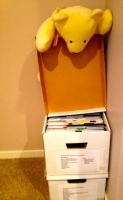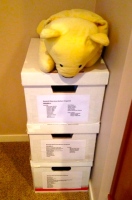Last month Phil and I made our third trip to the Baseball Hall of Fame in Cooperstown, New York. The first two trips were mainly pleasure trips in which we saw and enjoyed baseball history as preserved and presented by the Hall. The third trip was part pleasure, but mostly business — its main purpose was to turn over to the Library of the BHOF all of my thousands of pages of research notes on women in baseball, and also on Jack Graney and his bull terrier Larry, mascot of the Cleveland major league team 1912-17. (You can read about Jack Graney here.)
By donating these research notes to the NBHOF I will be making them accessible to researchers all over the world. Some of them, such as old newspaper clippings, can be found elsewhere by diligent research (though in separate places around the world, not all filed together as they are in my notes). But others, such as my interviews with Joe Dellacqua, Mary Gilroy Hockenberry, Wilma Briggs, Dottie Collins, and dozens of others, are unique: they can’t be found anywhere else except, now, the Library of the NBHOF.
Truth be told, I’m delighted that the NBHOF Library wants these research notes and will make them accessible to all. Donating them allows me to help others. After 28 years, it also relieves me of the responsibility of answering researchers’ questions about women in baseball between 1883 and 1993. Being relieved allows me to go forward with other projects and interests.
I started my research at the beginning of 1988 and finished in July of 1992, the same month I signed a contract with Harcourt Brace to publish Women at Play: The Story of Women in Baseball. The contract gave me a mere 92 days to write the book, and another three weeks after that to write the credits, captions, and permissions. The book was published in March, 1993.
During my four years of research, I created categories for what I was discovering. I kept my files in order, each sheet of paper within the proper file folder, each folder within the proper pocket, each pocket in the correct chronological order. But when I was confronted with a 92-day deadline in which to write a 50,000 word book that contained 99 photos, order rapidly disintegrated. Each day I worked from 5:30 a.m. to 11:00 p.m.— writing, rewriting, then rewriting once again. Under these circumstances, I had neither the time, the energy, or the interest to correctly refile all the notes I was frantically pulling out of various files each time I needed to check my facts.
By the time Women at Play was published in 1993, my files were . . . let’s just say they were no longer in order. And the very day the book was reviewed in The New York Times (March 4, 1993), I started receiving more information to supplement what I already knew. And the piles of new information I received were molehills compared to the mountains of questions I received via email, all of them inquiries about particular players, dates, games, etc. Each day for a couple of years I dug deep into my notes in order to answer questions . . . what had been a jumble grew into a sprawling mess.
 As I accumulated even more information and more notes, I stored file boxes in the storage locker . . . under the bed . . . in the exercise room . . . and of course in my office.
As I accumulated even more information and more notes, I stored file boxes in the storage locker . . . under the bed . . . in the exercise room . . . and of course in my office.
After the NBHOF Library asked if I would be willing to donate my research notes, and I agreed to do so, I chose a year in which I would turn my files over: Summer, 2016. At that time I didn’t know how many file boxes I would end up with. At least three, I was certain, and maybe seven. That’s why I scheduled my file-collecting work to start in November 2015, so that I would have from seven to nine months to get the files in order.
I finished the first file box toward the end of November. I finished the second toward the end of December. I was on a roll! I would finish by the end of March or April and take the rest of the spring and summer off!
But then life, as usual, intervened. In late December of 2015 I was asked by the Private Eye Writers of America if I was willing to be a judge for the Best First Private Eye Novel Award, to be presented at the Bouchercon in September 2016 — judges’ votes due May 31, 2016. I said yes, thinking that the reading of first private eye novels would not take too much of my time.
 Such was not the case. Even though there were only 20-some books to read and evaluate, the fact is that reading and evaluating takes more than twice as long as merely reading. So I didn’t finish the third file box until the end of February, 2016. But as I finished that particular box, I could see light at the end of the tunnel. First, I could see that my remaining research notes would occupy two more file boxes: no more. From the vantage point of February, I thought I could finish the last two boxes by mid-June.
Such was not the case. Even though there were only 20-some books to read and evaluate, the fact is that reading and evaluating takes more than twice as long as merely reading. So I didn’t finish the third file box until the end of February, 2016. But as I finished that particular box, I could see light at the end of the tunnel. First, I could see that my remaining research notes would occupy two more file boxes: no more. From the vantage point of February, I thought I could finish the last two boxes by mid-June.
Confession time. As I organized my files for the NBHOF, if I encountered any difficulties, I immediately shoved the difficulties aside, telling myself I would deal with them at the end of the project. Gotta keep things moving forward, you know. Which means that putting Box #4 together was a lot more difficult than putting Boxes 1 and 2 together: many of the things I shoved aside had to be decided upon by the fourth box. So I didn’t finish the fourth file box until mid-June.
Our hotel reservations for Cooperstown were set for late August, and I had already set a date of delivering the files to the Library on August 22. After I finished Box #4, I had nine weeks left in which to start and finish the fifth (final!) box.
Box #5 was the most time-consuming of all, because it contained my interview notes. For most of the interviews I had conducted between 1988 and 1992, I immediately typed the notes after I finished the interviews. While I spoke to the person, I took handwritten notes. When we finished talking, I swiveled my chair from my desk to my computer, opened a new word processing file on my Mac, and typed everything into a document. I would say that I did this for almost 90% of my interviews. But there were a few interviews, conducted late in the game, perhaps while I was writing the manuscript, that I never typed up at all.
 Back when I was typing the interview notes, spellcheck did not exist. So any typos I made stayed in the document and in its subsequent upgrades to new word processing programs. I didn’t want to present notes full of typos to the NBHOF: so my main job in putting together the interview notes was to run each document through spellcheck. And then to standardize the documents’ margins, pagination, and typefaces, so that they would look like they were part of a set.
Back when I was typing the interview notes, spellcheck did not exist. So any typos I made stayed in the document and in its subsequent upgrades to new word processing programs. I didn’t want to present notes full of typos to the NBHOF: so my main job in putting together the interview notes was to run each document through spellcheck. And then to standardize the documents’ margins, pagination, and typefaces, so that they would look like they were part of a set.
Of course I had to type up the handwritten interview notes that had somehow escaped my standard procedure twenty-eight years ago. Box #5 took longer than I thought it would — but I finished it before the end of July, 2016.
And on August 22, 2016, I delivered the five boxes to the BHOF Library.
I don’t know yet what my next book will be.
I do know that whatever it is, I will not accumulate thousands of pages of notes on it!
______________________
Some of Barbara Gregorich’s research notes (those covering the years from 1875 to 1934) can be found in Volumes 1, 2, and 3 of Research Notes for Women at Play: The Story of Women in Baseball.


3 responses to “Cooperstown Bound: Third Time’s a Trip”
[…] notes on women in baseball and donate them to the National Baseball Hall of Fame Library. (See Cooperstown Bound: Third Time’s a Trip). Before I did that, though, I ended up publishing the public-domain part of my notes in a […]
LikeLike
Thanks, Kit. It was a lot of fun to make the trip, visit the Hall again, and hand the files over. We also met Jack Graney’s granddaughter for lunch: she happened to be there the same day, to pick up a copy of that famous long photo in which Jack appears twice
LikeLike
Barbara, that’s quite a report! I congratulate you on taking the time to organize your research materials and to donate them to the Hall of Fame. The HOF is certainly fortunate to have your ‘treasure.’
Sincerely yours,
Kit Crissey
LikeLike